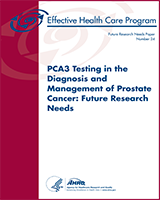NCBI Bookshelf. A service of the National Library of Medicine, National Institutes of Health.
Gutman SI, Oliansky DM, Belinson S, et al. PCA3 Testing in the Diagnosis and Management of Prostate Cancer: Future Research Needs: Identification of Future Research Needs From Comparative Effectiveness Review No. 98 [Internet]. Rockville (MD): Agency for Healthcare Research and Quality (US); 2013 Apr. (Future Research Needs Papers, No. 24.)

PCA3 Testing in the Diagnosis and Management of Prostate Cancer: Future Research Needs: Identification of Future Research Needs From Comparative Effectiveness Review No. 98 [Internet].
Show detailsKey Questions 1 and 2
- What modeling approach/algorithm would allow for the easiest inclusion of new markers while reducing the need for independent verification? Most reported multivariate modeling of prostate cancer risk relies on logistic regression. These models are difficult to compare across studies and do not allow for simple inclusion of new variables without re-computing all coefficients. Other models, such as multivariate overlapping Gaussian distributions, may fit the markers of interest and might allow for easier comparisons as well as the ability to easily add (or subtract) markers as knowledge increases. This could also allow for validation of partial models, if some markers have not been measured.
- What factors influence whether partial verification bias impacts the tPSA and/or the matched tPSA/PCA3 ROC curves? Factors that could be explored include the range of cancer rates, the range of verification rates, and the use of continuous versus categorical verification corrections. There have been only a handful of reports on tPSA use that address partial verification bias. A better understanding of this issue is needed if PCA3 is to be properly evaluated in the context of the widespread use of tPSA as triage test for treatment decisions.
- What absolute cut-offs or continuous values can be assigned to the PCA3 assay across the ROC curve? While the analyses in this review provide an approximate ROC curve allowing interpolation of sensitivity and false positive rates across the range of values, the absolute PCA3 and tPSA cut-offs may not be appropriate in every setting.
- Does our review’s literature restriction to matched studies provide more consistent and reliable comparisons than had the review used independent summaries of each marker’s performance? Given the increasing emphasis on comparative effectiveness analyses, a formal comparison of these two methods might provide useful guidance to future reviews.
- Does the reporting of matched analyses improve the usefulness of the dataset? Although our inclusion criteria required PCA3 and a comparator to be measured in the same population, it did not require a formal matched analysis to be reported. Thus, the reports did not allow for a comparison of how many men with cancer were identified by both markers, neither of the markers, or only one or the other marker. Requesting such analyses be performed using existing datasets would help answer this question.
- How can researchers studying PCA3 and other comparators be encouraged to provide proper reporting of statistical details? Proper reporting of statistical information on studies of PCA3 and the comparators was often absent in articles evaluated for this review. These include: confidence intervals, standard errors, prediction limits and other measure of dispersion and precision for all effect measures as well as good summary parameters for their data (e.g., selected centiles, medians, geometric means and trimmed logarithmic standard deviations). All studies identified were of poor quality when rated by QUADAS.
- How can systematic differences in marker levels due to reagents/manufactures be minimized or accounted for by analysis? Systematic differences between reagents/manufacturers exist for at least some of the markers that can influence the tests performance at fixed mass unit cut-offs.
Key Question 3
- Can intermediate outcomes, such as cancer classifications of aggressive or indolent tumors be properly validated? Given that current clinical practice guidelines employ unvalidated, or partially validated intermediate outcomes, it is difficult to design studies that would provide proper validation. Exploration of what study designs or re-analyses of existing dataset might provide stronger validation of select intermediate measures could be undertaken.
- What is the impact of use of PCA3 on long-term health outcomes when used to help select patients for active surveillance versus aggressive treatment?
- Methodological and Statistical Gaps in Knowledge About PCA3 Testing - PCA3 Testi...Methodological and Statistical Gaps in Knowledge About PCA3 Testing - PCA3 Testing in the Diagnosis and Management of Prostate Cancer: Future Research Needs
Your browsing activity is empty.
Activity recording is turned off.
See more...